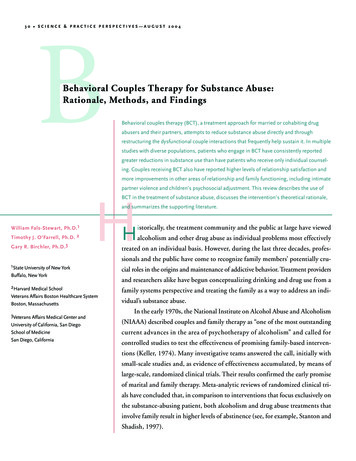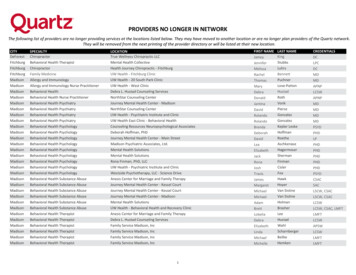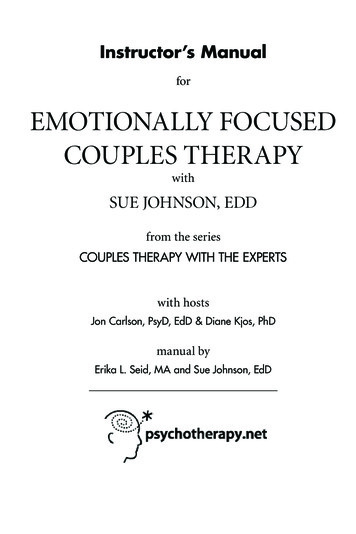
Transcription
MEDWIN PUBLISHERSMental Health & Human Resilience International JournalISSN: 2578-5095Committed to Create Value for researchersBehavioral Couples Therapy for Substance Use Disorders: AModel for ImplementationKlostermann K1*, Papagni E2 and Henninger MW3Review ArticleWalden University, USA2Medaille College, USA3University at Buffalo, USA1Volume 5 Issue 2Received Date: June 23, 2021*Corresponding author: Keith Klostermann, Walden University, 100 Washington AvenueSouth, Minneapolis, MN 55401; USA, Email: keith.klostermann@mail.waldenu.eduPublished Date: August 31, 2021DOI: 10.23880/mhrij-16000148AbstractThe important role of family in the development and maintenance of substance use disorders is now widely acknowledgedby researchers and clinicians alike. Behavioral Couples Therapy for Substance Use Disorders (BCT-SUD) is an evidencebased treatment based on social learning theory which posits that couples in which a partner has a substance use disorderare characterized by a reciprocal pattern of unhealthy substance use and negative relationship dynamics that reinforcerelationship dysfunction and problematic substance use. Despite BCT-SUD’s proven efficacy across several domains offunctioning, it is not widely implemented into practice. Therefore, the challenge for BCT-SUD researchers and clinicians alike isto identify comprehensive and systemic models for implementation which are not only feasible, but sustainable. The purposeof this paper is to provide a possible model for implementing BCT-SUD in practice as well as identify common barriers to theimplementation process.Keywords: Behavioral Couples Therapy; Evidence Based Treatment; DisordersAbbreviations: BCT-SUD: Behavioral Couples Therapyfor Substance Use Disorders; FIT: Feedback InformedTreatment.Behavioral Couples Therapy for SubstanceUse Disorders: A Model for ImplementationThe critical role of families in the development andmaintenance of substance use disorders is now widelyacknowledged by researchers and clinicians alike. Infact, previous literature has documented a bidirectionalrelationship between relationship discord and substanceuse, such as substance use being a potential response torelationship conflict and conflict may lead to substanceuse/misuse [1]. To absolve this, the incorporation of familymembers or significant others in the treatment processhas become increasingly common regardless of presentingconcern or level of care e.g., outpatient, in-patient; [2].Among couple and family treatments, Behavioral CouplesTherapy for Substance Use Disorders (BCT-SUD) has beenextensively studied with results consistently demonstratingsuperior substance use and relationship outcomes comparedto treatment-as-usual i.e., individual-based treatment [3].BCT-SUD is a conjoint approach which has steadily shown toproduce fewer substance-related issues, greater abstinence,and improved dyadic functioning compared to individualbased treatments for married and cohabitating couples [4].This finding has also been supported by the results of severalBehavioral Couples Therapy for Substance Use Disorders: A Model for ImplementationMent Health Hum Resilience Int J
2Mental Health & Human Resilience International Journalmeta-analyses, which found medium effect sizes favoringthe use of family and/or couples therapy relative to otherforms of treatment [4]. In addition to improvements in theprimary outcomes, patients receiving BCT-SUD also reportimprovements in secondary domains including intimatepartner violence [5], children’s adjustment, and cost [6].BCT-SUD is an evidence-based treatment based on sociallearning theory, which suggests that couples in which apartner has a substance use disorder are characterized by areciprocal pattern of unhealthy substance use and negativerelational dynamics, which serve to reinforce relationshipdysfunction and problematic substance use [7]. This circularpattern of substance misuse and dyadic dysfunction is oftenreferred to a “vicious cycle” with one negative behaviorprecipitating and reinforcing the other.The effectiveness of BCT for substance abusing patientsand their partners is no longer in question. In fact, Division50 of the American Psychological Association (EmpiricallySupported Treatments for Substance Use DisordersCommittee) recently reviewed the outcome evidence forBCT for alcohol dependence and concluded this treatmentmeets the criteria for “well established” treatment, which isthe highest level of empirical support recognized by Division50. Schumm and Renno’s [8] review also concluded thatBCT-SUD is suitable for real-world clinical settings and canbe adapted to meet the needs of the community in whichit’s being implemented, such as abbreviated formats andtelehealth protocols. However, despite its proven efficacyacross several different domains of functioning, BCT-SUD hasnot been widely implemented in practice. In fact, McGovernMP, et al. [9] examined community addiction providers(i.e., Directors [n 21] and clinicians [n 89]) experiences,beliefs, and readiness to implement a variety of evidencebased practices. Results were mixed; providers reportedmore readiness to adopt twelve-step facilitation, cognitivebehavioral therapy, motivational interviewing, and relapseprevention, while less ready to implement contingencymanagement, BCT, and pharmacotherapies. McGovernMP, et al. [9] concluded that in order for treatments tobe successfully disseminated, investigators must clearlydemonstrate the relevance of the treatment to cliniciansand staff, even if empirical support is already established.Thus, the challenge for BCT-SUD researchers and cliniciansalike is to identify comprehensive and systemic models forimplementation which are not only feasible, but sustainable[8]. The purpose of this paper is to provide a possible modelfor implementing BCT-SUD in practice as well as identifycommon barriers to the implementation process. UsingFixsen DL, et al. [10] recommendations for implementation,coupled with the Feedback Informed Treatment (FIT)implementation machinery, we propose a method forintroducing and implementing BCT-SUD in practice.ImplementationAccording to Rogers E [11], there are four main criteriawhich must be considered when considering translating aresearch program into practice: The innovation (e.g., BCT-SUD), Communication channels. Time (how long?). The social system itself.At a more individual level, Rogers E [11] asserts that anindividual’s decision to adopt or reject an evidence-basedpractice is influenced by: Relative advantage (i.e., how is the new service betterthan the old?). Compatibility (i.e., how does the new service fit withinthe current system?). Level of complexity or simplicity. Trial ability (can the individual test the new service inadvance of full implementation?). Observability (how visible is the service to others). Generally speaking, the goals of any implementationeffort are to create change in adult practitioner behavior,revise and refine organizational structure and culture(e.g., values, philosophies, ethics policies, procedures),and change relationships with clients, key stakeholders,and system partners.Implementation StepsSuccessful implementation requires a methodical andsystematic approach which may be best conceptualized asprocess, rather than a time-limited event, which involvesa series of sequential phases. It must be noted, that duringthe implementation process organizations may slide backinto earlier phases based on the practical realities of theorganization. In reviewing the implementation scienceliterature, Fixsen DL, et al. [10] identified six stages whichseem critical to implementing evidence-based practices: Exploration and adoption. Installation. Initial implementation. Full operation. Innovation. Sustainability.Each of these stages is described briefly below along withtheir implications for BCT-SUD.ExplorationIn this stage, key program personnel are tasked withexploring the match between the needs of the community,the evidence-based treatment and what is involved indelivering it, and the community resources with the goalof making an informed decision about whether to proceedKlostermann K, et al. Behavioral Couples Therapy for Substance Use Disorders: A Model forImplementation. Ment Health Hum Resilience Int J 2021, 5(2): 000148.Copyright Klostermann K, et al.
3Mental Health & Human Resilience International Journalwith the implementation or not. Assembling a small group ofinterested staff willing to introduce the approach to staff andkey stakeholders (administrators, supervisors, etc.) and beginto discuss the merits as well as the issues implementationof the new approach may present. Management support iscritical to the success of the implementation initiative.From a BCT-SUD perspective, some of the primaryconsiderations may involve provider attitudes towardscouples therapy, management involvement to support theeffort and in what ways (including financially), implicationsfor existing policy and procedures. Ultimately, the keyquestions during this phase involves feasibility.InstallationThis is typically the costliest stage of the implementationand involves creating structures to support the newtreatment, training supervisors in the approach, adjustingproductivity standards to accommodate the training efforts,running small pilot implementations, and identifying peoplewho are passionate about the new program and willing totake a risk (i.e., ‘champions’). During the installation phase,challenges are the norm and perfection is not expected;rather the goal may be best conceptualized as failing in asurvivable manner. The results of these efforts and lessonslearned in the pilots can be used to revise existing methodsand inform the larger implementation effort. During thisphase as well, it is critical that management participates inthe training so they are familiar with the scope of the newtreatment and have a better understanding of the systemic,clinical, and administrative changes required for successfulimplementation.In this stage, it is important to identify excited andenthusiastic BCT-SUD staff to serve as advocates for theprogram. If not easily identifiable, often during the trainingthese staff emerge as they become more excited about thepossibility of implementing a new treatment. The importanceof this role cannot be understated – these are the staff thatwill be critical in garnering support and working throughprogrammatic and procedural obstacles.Initial ImplementationThe information learned and structures put in placeduring the first two stages (i.e., exploration and installation)are now applied in practice during the initial implementation.According to Fixsen DL, et al. [10], “during the initial stageof implementation the compelling forces of fear of change,inertia, and investment in the status quo combine with theinherently difficult and complex work of implementingsomething new” (p. 16). Given the potential ambivalenceabout change, coupled with the introduction of a new wayof operating, Joyce BR, et al. [12] has referred to this stageas the “initial awkward phase.” As such, on-going coachingaround the new treatment, as well as changes in policy andprocedure are often necessary as a way to ensure continuedcompliance.This is a time where staff may need to be reminded thatthe new changes are not optional and require compliance oneveryone’s part. In the case of BCT-SUD, providers may notbe used to conducting couples therapy or even consideringit as an option. Administrators and clerical staff may alsobe unfamiliar with the billing process for the new service.It can also be helpful to examine what is working as well aswhat may need to modified or refined. During this phase, it isimportant to highlight and note the successes achieved thusfar and communicate this with all staff.Full OperationDuring this phase there is continued performancemonitoring at both the individual and organizational levelto incorporate new developments into existing practice andpolicies in an effort to maintain and improve the new policiesand procedures. Management and leadership are expected toproblem solve issues as needed and continue efforts to changethe culture. At this point, all staff is expected to apply the newtreatment which may involve adhering to new policies andprocedures. The goals during this stage include full staffing(as related to the new treatment), full client caseloads, activeand on-going referrals based on the inclusion/exclusioncriteria, practitioner skill in applying the intervention inpractice (i.e., adherence and competence in delivering themodel), managerial and administrative support for the newpolicies and practices, and community acceptance of the newservice [10]. In other words, the evidence-based treatmentbecomes part of the treatment as usual milieu.In this phase, all staff (clerical, providers, andadministrators) will be familiar with the BCT-SUD service,identified staff and supervisors will be appropriatelytrained, providers will be familiar with appropriate referrals,and this service will be fully integrated into the currentarmamentarium of services. Relatedly, BCT-SUD paperworkwill be fully integrated into existing policy, procedure, andrecord-keeping. During this phase, regular communicationamong staff about the new service and progress is importantto ensure consistency in messaging about the success of theprogram as well as any changes.SustainmentThe goal of this phase involves the long-term survivalof the new program within the context of an ever-changingand dynamic environment (e.g., turnover, changes in funding,Klostermann K, et al. Behavioral Couples Therapy for Substance Use Disorders: A Model forImplementation. Ment Health Hum Resilience Int J 2021, 5(2): 000148.Copyright Klostermann K, et al.
4Mental Health & Human Resilience International Journalnew practice guidelines). Sustainment is not an endpoint, butmay be best viewed as on-going process that involves proactive planning to handle issues and obstacles as they arisein order to ensure continued effectiveness and feasibility.Given the high rates of turnover among staff andleadership, coupled with limited (or shrinking) resources, itis critical that organizations plan ahead to deal with theseissues. In particular, it may be wise to offer on-going trainingfor new staff as part of orientation as well as regularlyscheduled boosters for current staff to ensure continuedadherence to the program [13].Common BarriersGiven the change process can be uncomfortable for many,as well as inertia, implementation problems are inevitable.Consequently, it’s highly recommended that practitionersand supervisors are held accountable for their efforts (orlack thereof) rather than the members of the implementationteam. In addition, it is also important to work with providersand administrators in tempering their expectations forthe implementation process. Many well intentioned andexcited providers/agencies interested in implementinga new treatment quickly fizzle out because of unrealisticexpectations. It’s important to note that implementation isa lengthy process and organizations and their staff are bestserved by thinking in terms of years, rather than months. Infact, successful implementation efforts may take 3-7 years toreach full implementation and sustainability. Unfortunately,many implementation efforts fail because leaders’ planningfallacy (i.e., not having a realistic sense of how long theseefforts take). Moreover, other common pitfalls involvethe misguided focus practitioner skill in delivering theintervention, rather than organizational change (e.g., policy,procedure) and lack of continuity in staffing (i.e., highturnover rates among leadership and key personnel).ConclusionAlthough BCT-SUD is an evidence-based treatment that isproven to be effective across several domains of functioning,it is not widely implemented into clinical practice. Therefore,the challenge for BCT-SUD researchers and clinicians alikeis to identify comprehensive and systemic models forimplementation which are not only feasible, but sustainable.Successful implementation requires a methodical andsystematic approach which may be best conceptualized asprocess, rather than a time-limited event, which involves aseries of sequential phase. Fixsen DL, et al. [10] identified sixstages that appear critical to implementing evidence-basedpractices and can be utilized for the implementation of BCTSUD: Exploration and adoption, Installation.Initial implementation.Full operation.Innovation.Sustainability.Following these six steps offers the implementationprocess a guided framework for reference as well as a morestreamlined process. Given that change can be difficult anduncomfortable, challenges are likely to arise during theimplementation process; however, there are strategies to tryto minimize barriers.References1.2.3.4.5.6.7.8.9.Mason R, O’Rinn SE (2014) Co-occurring intimate partnerviolence, mental health, and substance use problems: Ascoping review. Global Health Action 7(1): 1-17.Klostermann K, O’Farrell TJ (2020) Alcohol and othersubstance use disorders. In: Wampler K (Ed.), Handbookof Couple, Marital, and Family Therapy: The CoupleSubsystem in Couple, Marital, and Family Therapy. 3rd(Vol.), Wiley: UK, pp: 188-202.Klostermann K, Mignone T (2019) Behavioral couplestherapy for substance use disorders. Social BehaviorResearch & Practice 3(1): 25-27.O’Farrell TJ, Schumm JA, Dunlap LJ, Murphy MM,Muchowski P (2016) A randomized clinical trial ofgroup versus standard behavioral couples therapyplus individually based treatment for patients withalcohol dependence. Journal of Consulting and ClinicalPsychology 84(6): 497-510.Easton CJ, Crane CA (2016) Interventions to reduceintimate partner violence perpetration among peoplewith substance use disorders. International Review ofPsychiatry 28(5): 533-543.Mignone T, Papagni E, Mahadeo M, Klostermann K,Jones RA (2017) PTSD and intimate partner violence:Clinical considerations and treatment options. Journal ofAddiction Medicine and Therapeutic Science 3(1): 1-6.Byrne M, Carr A, Clark M (2004) The efficacy of behavioralcouples therapy and emotionally focused therapy forcouple distress. Contemporary Family Therapy: AnInternational Journal 26(4): 361-387.Schumm JA, Renno S (2021) Implementing behavioralcouples therapy for substance use disorders in realworld clinical practice. Family Process.McGovern MP, Fox TS, Xie H, Drake RE (2004) Evidencebased practices: Dissemination research in an addictionKlostermann K, et al. Behavioral Couples Therapy for Substance Use Disorders: A Model forImplementation. Ment Health Hum Resilience Int J 2021, 5(2): 000148.Copyright Klostermann K, et al.
5Mental Health & Human Resilience International Journaltreatment system. Journal of Substance Abuse Treatment26(4): 305-312.10. Fixsen DL, Naoom SF, Blase KA, Friedman RM, WallaceF (2005) Implementation research: A synthesis of theliterature. Tampa, FL: University of South Florida, Louisde la Parte Florida Mental Health Institute, The NationalImplementation Research Network, FMHI Publication.11. Rogers E (2003) Diffusion of Innovations. 5th (Edn.), FreePress.12. Joyce BR, Showers B (2002) Student Achievementthrough Staff Development. 3rd (Edn), Association forSupervision & Curriculum Deve (ASCD).13. Jacobson NS, Margolin G (1979) Marital therapy:Strategies based on social learning and behaviorexchange principles. Brunner/Mazer Publishers, pp:424.Klostermann K, et al. Behavioral Couples Therapy for Substance Use Disorders: A Model forImplementation. Ment Health Hum Resilience Int J 2021, 5(2): 000148.Copyright Klostermann K, et al.
Behavioral Couples Therapy for Substance Use Disorders (BCT-SUD) is an evidence-based treatment based on social learning theory which posits that couples in which a partner has a substance use disorder are characterized by a reciprocal pattern of unhealthy substance use and negative relationship dynamics that reinforce










